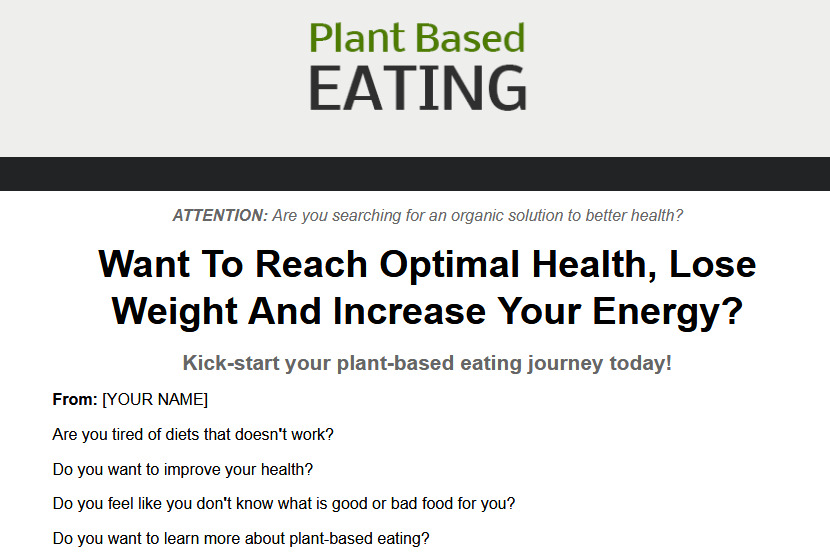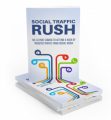Salespage Snapshot

Table of Contents
INTRODUCTION…..5
CHAPTER 1: WHAT IS PLANT-BASED EATING? ..7
WHY CHOOSE A PLANT-BASED NUTRITION?.. 9
CHAPTER 2: THE SCIENCE BEHIND PLANT-BASED EATING …. 11
FRUITS AND VEGETABLES .. 11
FIBER 12
SODIUM … 14
Sugar .. 14
PROTEIN … 17
CHAPTER 3: KICK-START YOUR PLANT-BASED LIFESTYLE ….. 20
STEP 1: CHOOSE YOUR TYPE OF PLANT-BASED NUTRITION 20
STEP 2: ADAPT YOUR GROCERY 22
STEP 3: PLAN YOUR MEALS 24
Breakfast … 25
Lunch .. 26
Dinner 26
STEP 4: LET’S DO THIS! ….. 26
CHAPTER 4: PLANT-BASED RECIPES . 28
BREAKFAST RECIPES .. 28
Overnight Oatmeal .. 28
Potato Breakfast Bowl…. 29
PLANT BASED EATING
The simpleton … 31
LUNCH RECIPES . 32
Cilantro, corn and black bean salad …. 32
Hummus Veggie Wrap … 33
Vegetable and lentil soup …… 34
DINNER RECIPES 35
Veggie and grain bowl … 35
Rice and beans with plantains …… 36
Risotto with roasted veggies . 39
SNACKS …. 41
Almond stuffed date 41
CHAPTER 5: ADDITIONAL TIPS FOR SUCCESS .. 42
WHAT IF I AM INVITED TO SOMEONE’S PLACE FOR DINNER? …… 42
WHAT IF I AM GOING OUT FOR A MEAL? … 43
WHAT IF I EAT MEAT BY MISTAKE? …. 43
IS POTATO CHIPS PLANT-BASED EATING? … 44
WHAT ABOUT MILK? . 44
WHAT ABOUT FAT? … 45
WHAT ABOUT PHYSICAL FITNESS? AND MENTAL HEALTH?.. 45
CONCLUSION …… 47
Sample Content Preview
Chapter 2: The Science Behind Plant-Based Eating
Research shows that we need more fruits and vegetables in our plates to prevent chronic disease and help with our weight management. In the next section, you will learn about what we need more in our nutrition intake (vegetables, fruits, fiber) and what we need less (sodium, sugar, protein) in order to live a healthier life.
Fruits and Vegetables
Plant-based eating means that you have a large proportion of your meal that comes from plant-based food. That said, fruits and vegetables are often the number one thing that comes to mind when we think of a plant-based nutrition.
According to some studies, only 15% of our population is able to meet the minimum requirement of daily recommendation for fruits and even less (10%) for vegetables. Experts in nutrition all across the world agree that the insufficient consumption of fruits and vegetables contribute to the obesity epidemic and chronic disease related to poor nutrition, especially in our country.
A report published by the World Health Organization (WHO) recommended that a daily intake of 400 g of fruits and vegetable would contribute to preventing chronic diseases which include diabetes, heart disease, cancer and obesity. To put this in perspective, 1 tomato is approximately 75 g while a medium size potato is about 150 grams. For fruits, a medium apple is about 150 g and a small kiwi is around 75 g.
Fiber
As mentioned earlier, fiber is lacking in the nutrition of Americans. It is recommended to consume from 25 g (women) to 38 g (men) of fiber on a daily basis. Unfortunately, we consume an average of 15 g daily. That is not enough for most of us and can have a negative impact on the bowels and cause constipation or hemorrhoids.
According to research, an increase intake in fiber can help prevent and reduce heart diseases, diabetes, and colon cancer.
You can find two types of fiber, water-soluble and water-insoluble. Water-soluble fiber can be found in fruits, vegetables, legumes, oat and bran. Since water-soluble fiber absorbs water during digestion, it can help decrease or prevent constipation. Fiber is also known to decrease the blood cholesterol levels.
As for water-insoluble fibers, they can be found in fruits, vegetables, whole grains and many cereals, including brown rice. The insoluble fiber wears that name because they remain.
Unchanged during the digestion and help with digestion, encouraging a regular movement in the intestine.
Here’s the approximate amount of fiber found in various plant-based foods:
– ½ cup of black beans, 7 g
– ½ cup of cooked broccoli, 5 g
– 1 Apple, 4 g
– ½ cup Bran cereal (no sugar), 14 g
– 1 cup cooked brown rice, 3.5 g
– 1 cup of oatmeal, 4 g
Sodium
Sodium might be considered a plant-based food but there is a strong warning to decrease our consumption so that we don’t exceed the requirements of 2300 mg of sodium consumption daily. The salt shaker in your kitchen is rarely the culprit. The sodium usually comes from highly processed foods (frozen aisle in the grocery store) and restaurant meals.
For example, a fast-food burger can have twice the sodium a homemade one has. According to some research, individuals who regularly consume a meal at fast-food restaurants were approximately 296 mg above the recommended daily intake.
Other studies indicate that individuals who had a plant-based nutrition with reduce sodium consumption (2300-1500 mg a day) showed a reduction in blood pressure and increased weight loss. That said, it is important to understand that plant-based food doesn’t always mean healthy food. Sugar is the other plant-based food to beware of.
Sugar
Did you know that we are among the largest sugar producers in the world? And we are also high consumers of sugar (3rd country in the world after India and China). The average American will consume 152 pounds (six 25 lb. bags of sugar cane) of sugar a year.
Some people will try to convince you that some sugars are better than others. It is true that different types of sugars will have a different impact on your metabolism. But sugar remains something that you should not consume in a large quantity no matter if it is coming from fruit juices, honey, or a muffin.
It is recommended to stick to less than 50 g of sugar a day. A packet of sugar is about 4 g, one glass of cow milk is around 14 g of sugar, a popular brand of store-bought muffin is approximately 32 g of sugar added.
We challenge you to start looking at the labels of the food you eat on a daily basis and identify the amount of sugar intake you get from those foods. You will be quickly surprised to see that sugar is added to so many products we purchase. Even canned vegetables can have added sugar.
By reducing your sugar intake, you increase your chance of losing weights and staying healthy while preventing chronic disease. Reading labels can be difficult, look for the word sugar on the nutrition label, you will see how many grams of sugar there is in the product. Many companies hide the ingredient by using multiple names to describe the sugar added, they use at least 60 names for sugar on labels.
Companies do it that way because they can “divide and conquer” if they only used the name sugar, it would often be one of the first ingredients on the list (which is in order of quantity) and that would tell us that it’s not a healthy option. In order to confuse you (even more) into submission, they categorize the type of sugar by its scientific name so that they can have 10 small amounts of sugar instead of one large amount of sugar.
Here’s an example, the order of ingredients on a popular can of pumpkin pie filling reads like this: pumpkin, water, sugar, salt, spices, dextrose, natural flavors. Dextrose is a type of sugar, and some companies chose to use that term instead of sugar because it would’ve placed sugar before pumpkin in the ingredient list. Same with a popular bottle of our ketchup that has the following ingredient label: tomato concentrate from ripe red tomatoes, distilled vinegar, high-fructose corn syrup, corn syrup, salt, spice, onion powder, natural flavoring.
Other Details- 10 Articles (TXT, DOC)
- 1 Ebook (PDF), 48 Pages
- 1 Graphic (PNG)
- 1 Salespage (HTML)
- 1 Keywords List (PDF)
- Checklist, Lead Magnet, Optin Page, Social Media Messages, Opt-in Page Headline, Email Swipes, Salespage Headline, Infographic
- Year Released/Circulated: 2020
- File Size: 28,848 KB
License Details:
Yes can be sold
Yes can sell/resell rights/master resell rights to this product; Suggested Resell $7-$20
Yes you may edit the squeeze/sales page
Yes can be added to a paid membership site
Yes can give the eBook away for FREE
You do NOT have Private Label Rights. You may NOT sell or give away private label rights
You may NOT re-title or edit the contents of this product














